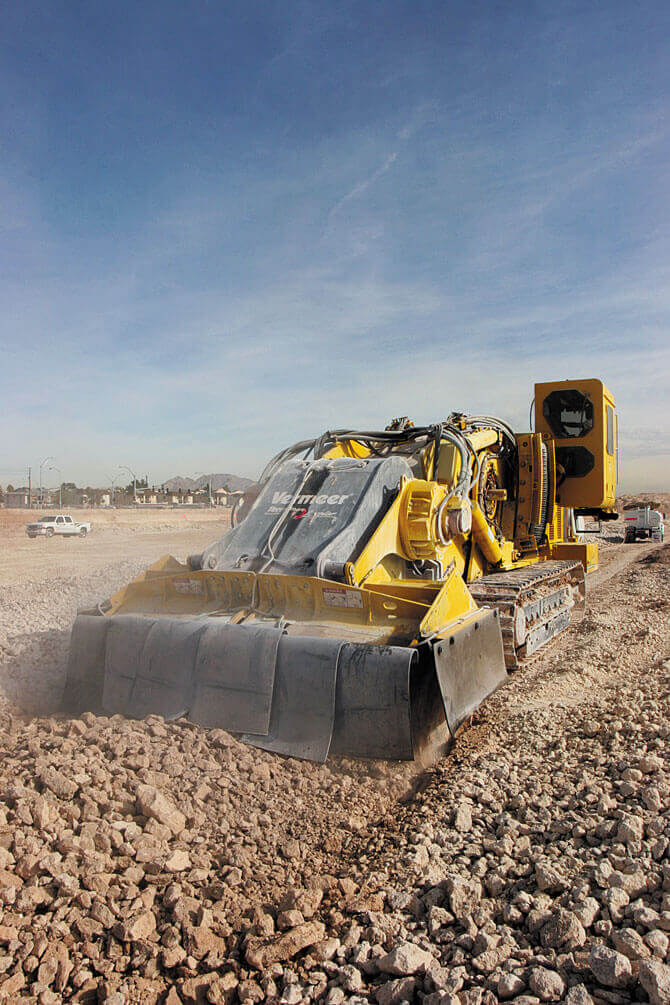Flying rock debris, dust, noise and vibrations — these are a few of the common safety concerns for surface mining operations. For more than a century, drilling holes into hard rock and using explosives is the first step of processing the mineral-rich material and aggregates. While miners try to account for every potential hazard, there will always be inherent risks for workers and the surrounding area when explosives are used.
In an effort to mitigate the safety risks associated with drilling and blasting, as well as create more sustainable mining practices, surface mining operations around the world have begun to implement precision mining methods. Heavy machinery, known as surface excavation machines, equipped with powerful cutting wheels are used to break up hard, rocky material at precision mining operations. Mines utilizing these machines have been able to reduce the amount of explosives used to extract material, helping to alleviate miner and community safety concerns.
According to Vermeer Specialty Excavation Application Engineer, Tyler Sikora, the rise in precision mining methods is one of the ways surface mining operations are addressing an increasing number of stringent regulations pertaining to the use of explosives. “Most countries have strict guidelines for handling and storing explosives, which is driving mining costs up,” he explained. “And, for many large mining operations, there is increasing pressure from nearby communities to reduce the amount of noise, vibration and dust normal mining practices produce.”
Vermeer is one of the manufacturing companies coming to the aid of surface miners. In 2002, the Pella, IA, manufacturer developed the Vermeer Terrain Leveler® surface excavation machine (SEM). The large and powerful machine provides surface miners with a safe and cost-efficient alternative to drilling and blasting. “Machines like the Terrain Leveler SEM, do not require the use of explosives,” Sikora explained. “Instead, the machine uses cutting wheels with durable carbide teeth to excavate the material. This process helps eliminate dangerous flying debris, minimizing a major safety concern for miners when they use explosives. Also, there is much less vibration and dust produced by these machines, which is beneficial for workers and the surrounding community.”
Another attribute of precision mining machinery that is helping with mining safety is how much more efficient the process is. Drilling and blasting require several more steps. First, blasthole drills create the holes to hold the explosives. The holes are then loaded and detonated creating rubble that has to be filtered and crushed before it is ready to transport. Throughout the process, mine workers often need to operate machinery in less than ideal terrain.
“There are fewer steps involved with precision mining, and most operations are able to significantly reduce the number of times material needs to be handled,” said Sikora. “With surface excavation machines like the Vermeer Terrain Leveler, an operator can plot out an area using GPS, and the machine will extract material a layer at a time. The process produces consistently sized material that typically does not need to be run through a crusher. A pressurized cab limits the operator’s exposure to dust particles and helps to filter out noise. Some machines can even be operated by remote control — a particularly useful feature for working near to obstacles like roads, pipelines or mine walls.”
Sikora also says that surface excavation machinery creates a flat mine floor for the haul trucks that transport the material. “Rough haul roads can be a real danger for miners. Sharp rocks can puncture tires, and uneven terrain can create unsafe conditions for truck drivers.”

In addition to being safe and efficient, precision surface mining methods are helping miners create better sustainability practices. The vibrations caused by blasting can damage nearby infrastructure, including roads, utility lines, pipelines and buildings. To avoid this, mines are forced to abandon areas within close proximity to these obstacles. Surface excavation machines produce significantly less vibration and can work closer to existing infrastructure, helping to reduce the amount of mineral-rich material wasted.
“The ability to excavate in these areas, allows mining companies to extract more material in less space, which can help reduce their operational footprint,” said Sikora. “Surface excavation machines also have the ability to precisely extract the ore from the waste, or ores of varying chemistry, and mine thin seams and non-homogenous ore bodies, which also cuts down on wasted material.
“Those attributes, along with the reduction of the dust and vibration created by explosives makes surface excavation equipment more sustainable and environmentally friendly than drilling and blasting,” Sikora added.
Mining plays a vital role in everyone’s daily lives. The material extracted by surface mining operations create energy and are used by manufacturers to produce many of the machines and gadgets people use every day. Through the use of precision mining methods, today’s miners are actively taking steps to make mines safer, more sustainable and better neighbors to nearby communities.
The future of mining is precision.